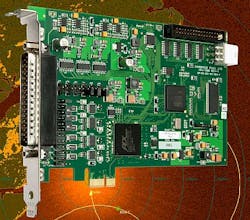PCI Express radar output card for testing ahead of deployment introduced by Cambridge Pixel
LITLINGTON, England, 30 Aug. 2013. Cambridge Pixel in Litlington, England, is introducing the HPx-300 PCI Express radar output card designed to enable developers of radar tracking or radar display applications to perform an end-to-end test of their systems in the laboratory ahead of deployment with a radar.
The HPx-300 generates radar signals, including video, trigger, azimuth and ship heading, to support radar system test, simulation and video streaming. The card offers flexibility for generating analogue and digital signal types and voltages, permitting many types of radar signals to be simulated.
The card also can be programmed to simulate a wide range of rotation speeds, radar pulse rates and scanning types, including conventional rotating, sector and random scan.
The HPx-300 card can be used with Cambridge Pixel's Windows-based SPx Simulator software to generate realistic radar video signals comprising targets and terrain, with synchronized track reports, navigation and secondary radar.
Also, for simulation and training applications, the SPx Simulator software combines with the HPx-300 card to provide a capable ready-to-run PC-based radar simulator. The HPx-300 card can be supplied with a low-level board support package, the SPx Development software or the SPx Simulator application.
For more information contact Cambridge Pixel online at www.cambridgepixel.com.
